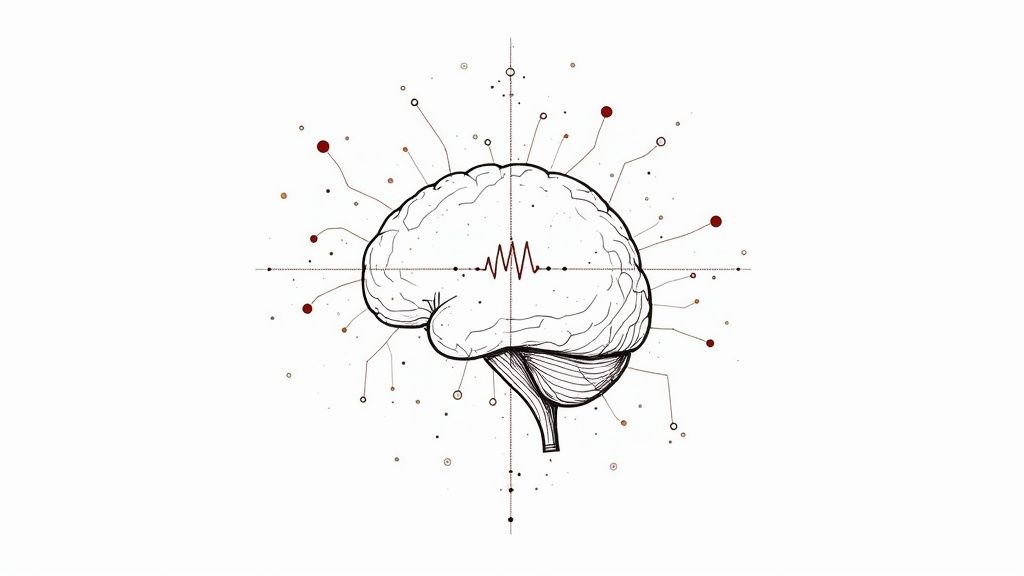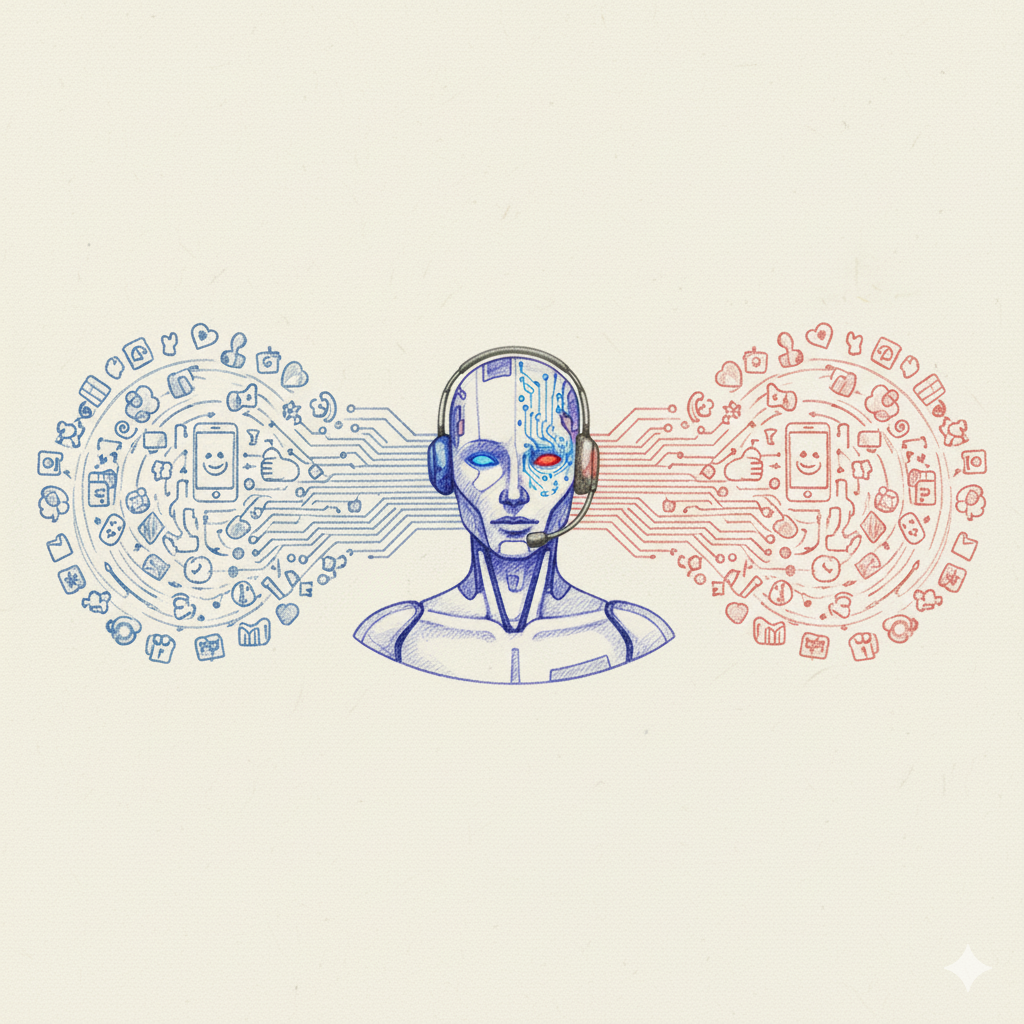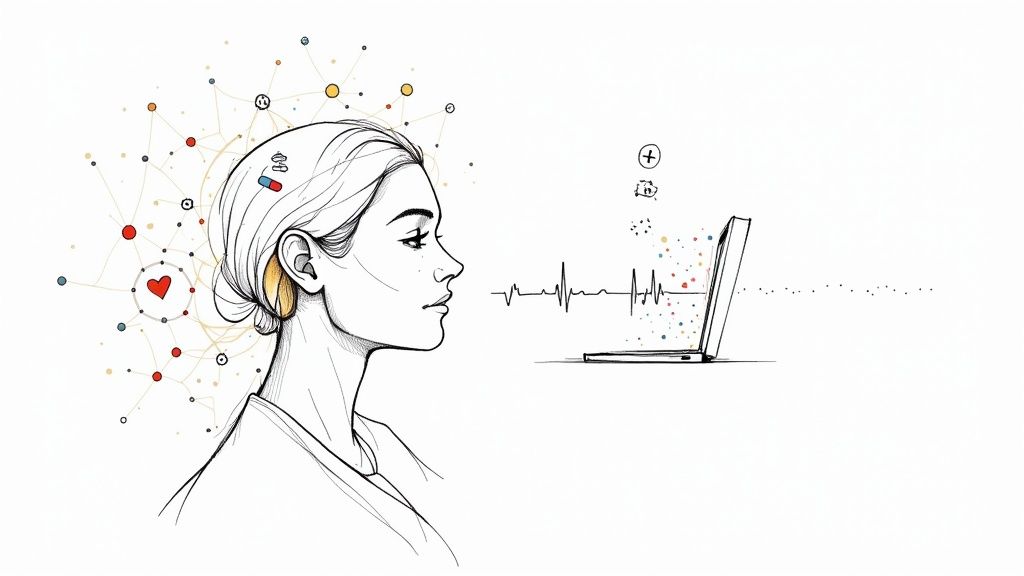A Guide to Medical AI in Modern Healthcare
Discover how medical AI is transforming patient care. This guide explains key applications, benefits, and the future of AI technology in healthcare.
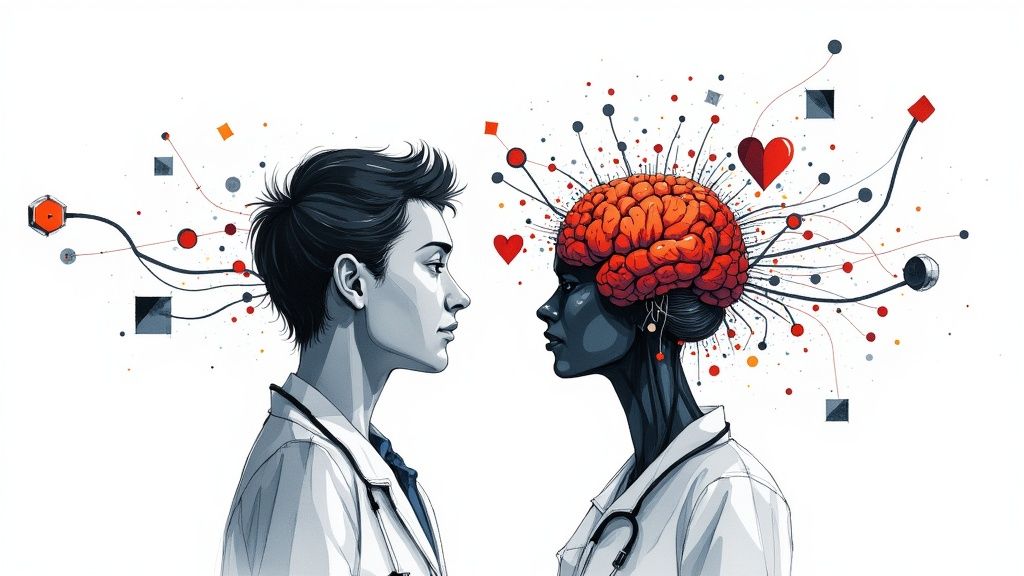
When we talk about medical AI, we're really talking about using artificial intelligence and machine learning to make sense of healthcare data. The goal is to help, enhance, and even automate tasks for both clinicians and administrators.
Think of it as a powerful partner for medical professionals. This technology can analyze incredibly complex information—from MRI scans to patient records—and pull out insights that lead to better patient outcomes. At Ekipa, we build powerful AI Solutions and provide expert AI strategy consulting to help healthcare organizations navigate this new frontier.
What AI in Medicine Means for Patients and Providers
This isn't some far-off sci-fi concept. Medical AI is already a real, active part of modern healthcare, and it's fundamentally changing how care is delivered. It’s not about replacing doctors with robots; it’s about giving them incredibly sharp tools to do their jobs even better.
This technology acts as a force multiplier, amplifying human expertise. The result? Faster diagnostics, truly personalized treatment plans, and accelerated life-saving research.
Imagine an AI reviewing thousands of mammograms, flagging subtle anomalies the human eye might miss. Or picture a system that analyzes a patient's unique genetic code to recommend the most effective cancer treatment. This is the practical reality of medical AI today. It crunches massive datasets far beyond what any person could, finding patterns that lead to earlier detection and more precise care.
Enhancing Human Expertise
The real value of AI in medicine is its ability to support clinical judgment, not replace it. It's brilliant at specific, data-heavy tasks, which frees up healthcare professionals to focus on what they do best: patient care, complex decision-making, and providing a human touch.
This human-machine collaboration is what makes the entire system more efficient and effective.
Here are a few key areas where AI is already making a huge difference:
- Diagnostic Support: AI algorithms can analyze medical images like X-rays, CT scans, and MRIs with stunning accuracy, often spotting conditions much earlier than traditional methods.
- Operational Efficiency: From optimizing hospital bed management to automating tedious paperwork, AI takes on repetitive tasks so staff can focus on more critical activities.
- Predictive Analytics: By analyzing patient data, AI can forecast the likelihood of a disease progressing or identify patients at high risk for conditions like sepsis, allowing for proactive intervention.
Medical AI is essentially a tireless, data-driven assistant. It can sift through millions of data points without getting tired, presenting clinicians with clear, actionable insights to inform their final, expert decisions.
From Theory to Clinical Practice
The gap between academic research and real-world application is closing fast. Hospitals and clinics are bringing AI-powered tools into their daily workflows to improve everything from diagnostics to patient management. As we explore in our guide to AI in the healthcare industry, this kind of integration is becoming a must-have for delivering the highest standard of care.
This technology is no longer limited to major research institutions. It's becoming an accessible and vital part of the healthcare toolkit, pointing toward a future where medicine is more predictive, personalized, and efficient for everyone.
How Medical AI Actually Learns and Works
Forget the idea of a magical black box. The best way to think about medical AI is to picture a highly specialized, incredibly diligent student. It learns by sifting through massive amounts of data, much like a medical resident studies countless patient charts, lab results, and diagnostic images to build their expertise.
The core technologies making this happen are machine learning (ML) and natural language processing (NLP).
Imagine an ML model being trained to spot the earliest signs of diabetic retinopathy from retinal scans. It's fed hundreds of thousands of images—some from healthy patients, others from people with the condition. With every image, the algorithm fine-tunes its understanding, gradually learning to recognize the tiny, almost invisible patterns that signal disease, like micro-aneurysms or lipid deposits. It doesn't get tired or distracted; it just keeps learning until it becomes exceptionally good at that one specific task.
This entire process is designed to turn raw data into a reliable tool that can help a clinician make a better, more informed decision.
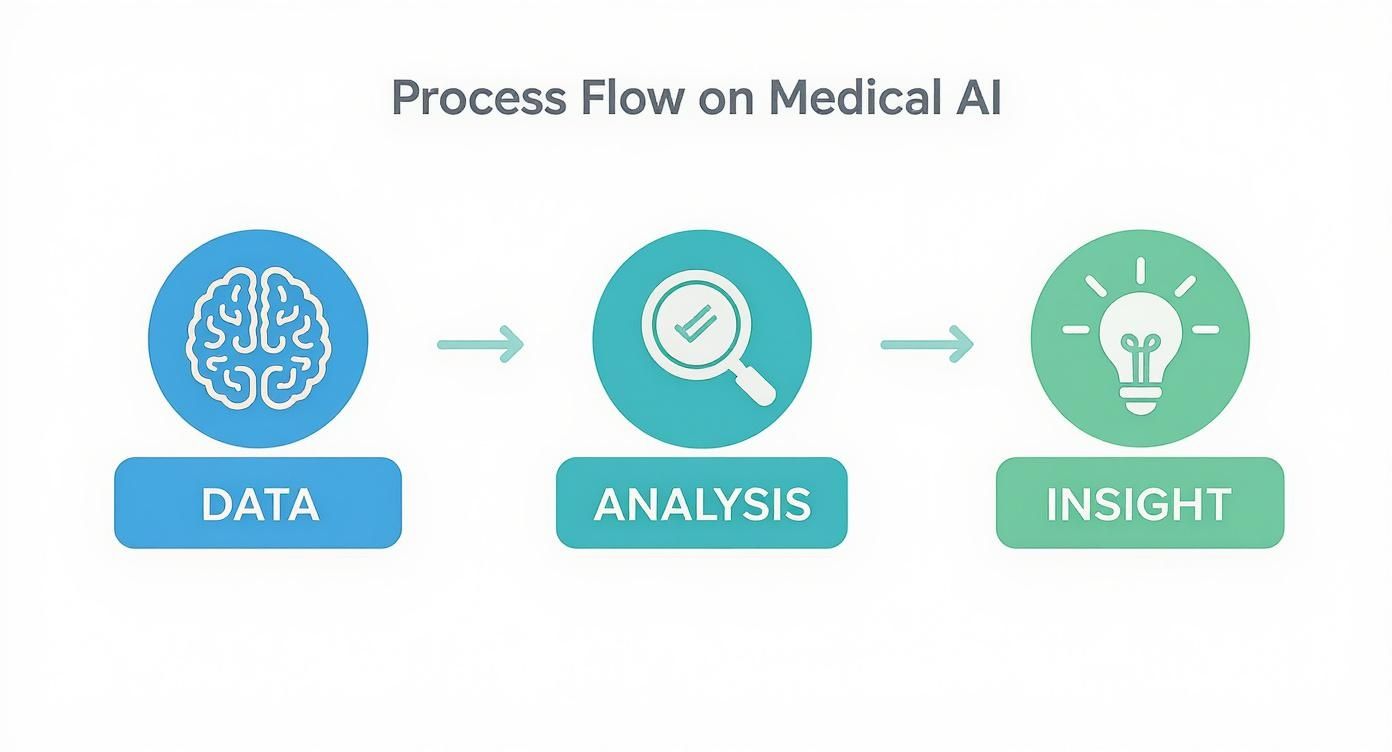
As you can see, it all starts with good data. That data is fed into a sophisticated algorithm, which then produces an insight a healthcare professional can actually use.
The Brains of the Operation: Machine Learning and NLP
Machine learning is really the engine driving most medical AI. It’s a field of AI where algorithms aren't given a strict set of rules. Instead, they learn to find patterns on their own, directly from the data they're given. This is absolutely critical in medicine, where the complexities of human biology are far too nuanced for simple if-then programming.
Natural language processing, on the other hand, gives AI the ability to read and understand human language. In a healthcare setting, this is a game-changer. Why? Because so much vital patient information is locked away in unstructured text.
Think about a doctor's clinical notes. They’re full of rich, critical information, but they’re also notoriously difficult to analyze systematically. NLP algorithms can comb through these notes, pull out key details like symptoms, medications, and diagnoses, and organize that information so it can be used for large-scale analysis.
This ability to make sense of both structured data (like lab results) and unstructured data (like a doctor's notes) is what gives modern medical AI its power. The investment in this space tells the story—the global AI in healthcare market is exploding, with valuations ranging from USD 14.92 billion to USD 29.01 billion. While the exact numbers differ between reports, the trend is undeniable.
Training the AI Model
At the end of the day, a medical AI model is only as good as the data it’s trained on. If you feed it a biased or incomplete dataset, you’ll get a biased and unreliable tool. It's that simple. That's why curating high-quality, representative data is one of the most important—and difficult—steps in building any medical AI solution.
To really get a feel for what’s happening under the hood, it helps to break down the primary AI technologies and what they do.
Core AI Technologies in Medicine
The table below gives a quick snapshot of the main AI technologies driving innovation in healthcare, what they do, and where you’d typically see them in action.
| AI Technology | Core Function | Example Medical Application |
|---|---|---|
| Machine Learning (ML) | Learns patterns from large datasets to make predictions or decisions without being explicitly programmed. | Predicting a patient's risk of readmission based on their electronic health records. |
| Natural Language Processing (NLP) | Enables computers to understand, interpret, and generate human language from text and speech. | Analyzing clinical notes to find eligible patients for a clinical trial. |
| Computer Vision | Allows AI to interpret and understand information from digital images and videos. | Detecting cancerous tumors in MRI scans or identifying fractures in X-rays. |
Each of these technologies plays a unique role, but they often work together to solve complex clinical problems.
The foundational algorithms that power these tools are constantly evolving, driven by ongoing research in biological and mathematical sciences. This deep scientific work is what allows us to turn these advanced concepts into reliable, real-world applications that can truly make a difference in patient care.
Real-World Applications of Medical AI
This is where the rubber meets the road—where the theoretical promise of medical AI translates into real-world clinical impact. AI in healthcare isn't some far-off concept anymore. It's already at work in hospitals and clinics, solving tangible problems, improving patient outcomes, and making daily operations run smoother. The applications are surprisingly diverse, touching everything from diagnostic imaging to the nuts and bolts of hospital administration. You can explore many of these real-world use cases in our library.
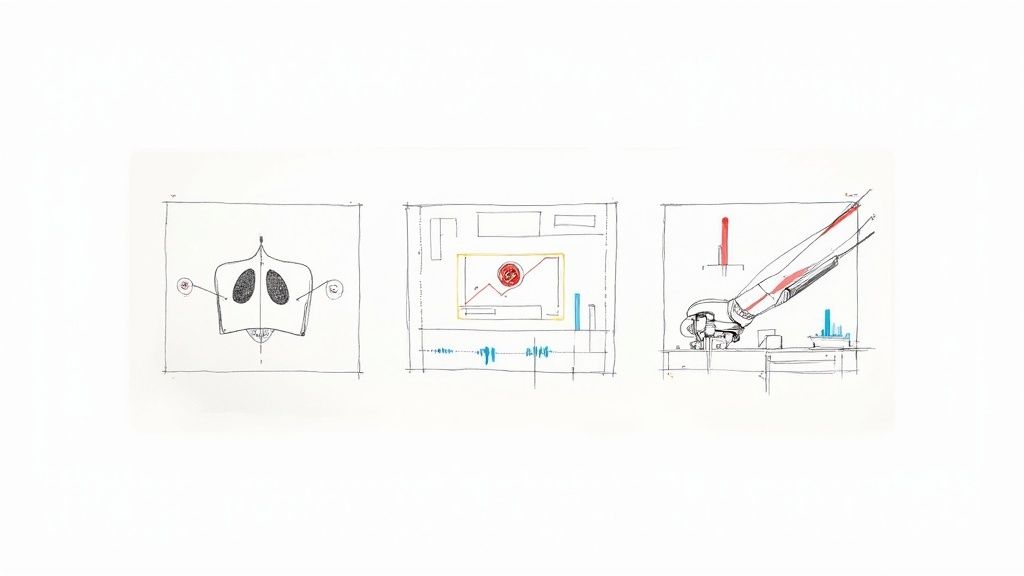
It’s important to see these tools for what they are: powerful partners for clinicians. They aren't replacements. Instead, they help doctors see more, understand faster, and act with greater confidence. Let's look at some of the most powerful ways medical AI is being used right now.
AI-Powered Medical Imaging Analysis
If there's one area where medical AI has truly come of age, it's in analyzing medical images. Radiologists and pathologists spend their entire careers scrutinizing scans for the faintest signs of disease. It's an incredibly demanding and time-consuming job.
AI algorithms, especially those built on computer vision, are a natural fit for this kind of work. After being trained on millions of scans, they become exceptionally good at spotting patterns that might be subtle or even invisible to the human eye, flagging areas of concern for an expert to review.
- Early Cancer Detection: AI models can analyze mammograms, CT scans, and MRIs to spot tumors in their earliest stages. The accuracy often matches or even surpasses human performance, which can lead directly to earlier diagnoses and better treatment results.
- Neurological Insights: In neurology, AI helps comb through brain scans to find early markers for conditions like Alzheimer's disease or multiple sclerosis, opening the door for much earlier intervention.
- Ophthalmology: A great example is our own AI-powered diagnostic assistant, Diagnoo. It shows how AI can help ophthalmologists by analyzing retinal scans for signs of diabetic retinopathy, which is a leading cause of blindness. You can explore Diagnoo's capabilities at https://www.ekipa.ai/products/diagnoo.
Think of this technology as a highly trained second set of eyes. It reduces the risk of a missed diagnosis and frees up specialists to focus their expertise on the most complex and ambiguous cases.
Predictive Analytics for Proactive Care
Medical AI is also fundamentally changing the healthcare model from reactive to proactive. Using predictive analytics, algorithms can sift through massive datasets of electronic health records (EHRs) to pinpoint patients who are at high risk for developing certain conditions before they become emergencies.
By identifying these at-risk individuals early, healthcare providers can intervene proactively with preventative care, personalized monitoring, and targeted treatments, ultimately preventing serious health events and reducing hospital readmissions.
For example, a hospital could use a predictive model to flag patients with a high probability of developing sepsis, a life-threatening condition. This gives the clinical team a critical head start, allowing them to begin monitoring and treatment protocols immediately and dramatically improving the patient's chances of survival.
Streamlining Hospital Operations
Beyond direct patient care, AI is also making a huge difference on the administrative side of things. Hospitals are incredibly complex operations, and the logistical challenges are immense. From managing the constant flow of patients to handling billing, the administrative load is a primary source of inefficiency and clinician burnout. This is where healthcare software development and AI intersect to create powerful solutions.
This is where intelligent workflow automation steps in. AI can optimize many of these background processes, creating a more efficient and responsive healthcare environment for everyone.
- Optimized Scheduling: AI algorithms can manage patient appointments and surgical schedules to cut down on wait times and make sure expensive resources like operating rooms are used to their full potential.
- Efficient Bed Management: Predictive models can forecast patient admissions and discharges, helping hospitals manage bed capacity and avoid bottlenecks.
- Automated Administrative Tasks: Natural Language Processing (NLP) is now used in internal tooling to scan doctors' notes and automatically pull out the correct billing codes. This simple change slashes the time spent on manual data entry and reduces costly errors.
By taking over these logistical and administrative headaches, medical AI gives clinicians back their most valuable resource: time to focus on caring for patients.
Measuring the Benefits and ROI of Medical AI
Thinking about investing in medical AI? It’s not just about getting the latest tech toy. It's a serious business decision that can pay off in big ways—clinically, operationally, and financially. The real value isn't just in the algorithm; it's in the ripple effect it creates, making your entire organization more efficient and improving the care you provide. If you want to build a solid case for adoption, you have to understand how to measure these returns.
Clinically, the most obvious win is better patient outcomes. When AI tools help sharpen diagnostic accuracy, you can catch diseases earlier and craft treatment plans that are truly personalized. This does more than save lives—it cuts down on expensive medical errors.
Operationally, think of medical AI as a powerful efficiency engine. It can take over the tedious, time-consuming administrative tasks and streamline complicated hospital workflows. This frees up your doctors, nurses, and staff to do what they do best: care for patients. That’s a huge boost for both staff morale and the quality of care.
Quantifying the Financial Impact
It's no surprise that these clinical and operational gains lead to a solid return on investment (ROI). The financial benefits stack up from several different directions, making a clear-cut business case for bringing these technologies on board.
The investment world has certainly caught on. Just look at where the money is going. Global investment in AI diagnostics companies has already hit $7.1 billion. Venture capital funding for AI-powered drug discovery startups jumped by 31% in just one year. Governments are getting in on the action, too, with the U.S. government earmarking $2.4 billion for healthcare AI innovation. The financial momentum is impossible to ignore. Discover more insights on AI healthcare investment.
So, where exactly do healthcare organizations see the money coming back?
- Lower Operational Costs: When you automate things like medical coding, scheduling, and managing supplies, your administrative overhead drops. You simply need less manual effort to get things done.
- Higher Patient Throughput: AI can help optimize operating room schedules and manage the flow of patients through the hospital. This means you can treat more people without sacrificing the quality of care.
- Fewer Readmissions: Using predictive analytics, you can spot high-risk patients before they leave the hospital. This lets you step in with proactive care to prevent them from coming back, which saves a ton of money on avoidable readmissions.
- More Accurate Billing: AI tools can scan clinical notes to ensure the billing codes are spot-on. This cuts down on denied claims and keeps the revenue cycle running smoothly.
Building a Strategic Roadmap for Success
Of course, these benefits don't just magically appear. You need a smart, deliberate plan. As we've explored in our AI adoption guide, a clear strategy is everything. It makes sure you're putting your money where it will solve your biggest problems.
A successful medical AI initiative starts with identifying specific, high-impact problems and then matching them with the right technological solution. It’s not about adopting AI for its own sake, but about using it to solve real-world clinical and operational pain points.
This is why having a detailed plan is so critical. A Custom AI Strategy report can give you that roadmap. It helps you map out your investments, figure out the right key performance indicators (KPIs) to track, and forecast your financial returns with confidence. It turns the promise of AI into a concrete business plan that ties the technology directly to your goals, ensuring every dollar you spend delivers real value.
Navigating Implementation Challenges and Regulations
Bringing medical AI into a hospital or clinic isn't like flipping a switch on a new piece of software. It’s a major operational undertaking, and it comes with its own unique set of headaches. To really get these powerful tools working in a real-world clinical setting, you have to carefully navigate technical hurdles, data quality nightmares, and a tangled web of regulations.
Let’s be honest: one of the biggest roadblocks is the data itself. AI models are data-hungry, but they’re also picky. They need vast amounts of high-quality, diverse, and accurately labeled data to learn from. Just finding that data is tough enough, but you also have to make sure it’s not riddled with biases. If an algorithm learns only from data on a specific patient group, its insights could be flat-out wrong for everyone else, which can make health inequities even worse.
Then there's the "black box" problem. It's completely reasonable for a doctor to be skeptical of an AI's recommendation if they can't see how it reached that conclusion. Building trust means we need to move towards more transparent and explainable AI (XAI)—models that can actually show their work. This lets medical professionals see the logic and feel confident in the AI's suggestions.
The Evolving Regulatory Landscape
Healthcare is, and should be, a heavily regulated field. AI is no different. Patient data privacy is everything, so complying with laws like HIPAA is non-negotiable. Any organization using AI has to have rock-solid security protocols to protect the sensitive patient information these systems rely on.
At the same time, the rules for AI-powered medical devices are starting to catch up. Regulatory bodies like the FDA are actively building out frameworks to properly evaluate and approve these technologies. And things are moving faster than you might think, which signals a growing official acceptance of AI’s place in medicine.
Consider this: in one recent year, the FDA gave the green light to 223 AI-enabled medical devices. That's a huge leap from just a handful a few years prior. This trend shows just how seriously the medical establishment is taking AI's potential to improve how we diagnose and treat patients. You can read the full analysis on AI medical device approvals to see just how fast things are changing.
Getting medical AI right is a delicate balancing act. You need the technical know-how to integrate complex systems, the strategic vision to manage data quality and ethics, and an obsessive focus on regulatory compliance to keep both patients and your organization safe.
Forging a Path to Successful Deployment
Getting over these hurdles takes a smart mix of technical skill and practical guidance. One of the biggest technical headaches is simply getting a new AI platform to talk to your existing systems, like the electronic health records (EHR) you've been using for years. Without specialized knowledge, it can be a nightmare.
That’s why a phased approach is almost always the best bet. Start small. Pick a well-defined project to prove the concept, build some momentum, and show people the value.
Here's a simple way to think about it:
- Pinpoint a Specific Problem: Find a clear, high-impact issue in your clinical or operational workflow where AI could make a real difference.
- Get Your Data Ready: Take a hard look at your data. Is it clean? Is it secure? Is it representative of your patient population?
- Choose the Right Tool: Don’t just grab the flashiest new thing. Pick an AI solution that is transparent, fits your goals, and actually works with your current setup.
- Run a Pilot Program: Test the technology in a controlled setting. This lets you measure the real impact and get crucial feedback from clinicians before a full-scale rollout.
Pulling this off methodically requires real expertise. A well-managed rollout, guided by a clear AI Product Development Workflow, is what separates a successful, compliant deployment from a costly failure.
The Future of AI in Medicine
So, what's next for AI in medicine? We're on the brink of some truly incredible breakthroughs that will shift AI from a helpful diagnostic assistant to a creative partner in healthcare. The next wave of innovation is all about moving from analyzing what is to creating what could be.
It's not about making doctors obsolete; it’s about giving them supercharged tools to see further and work faster than ever before.
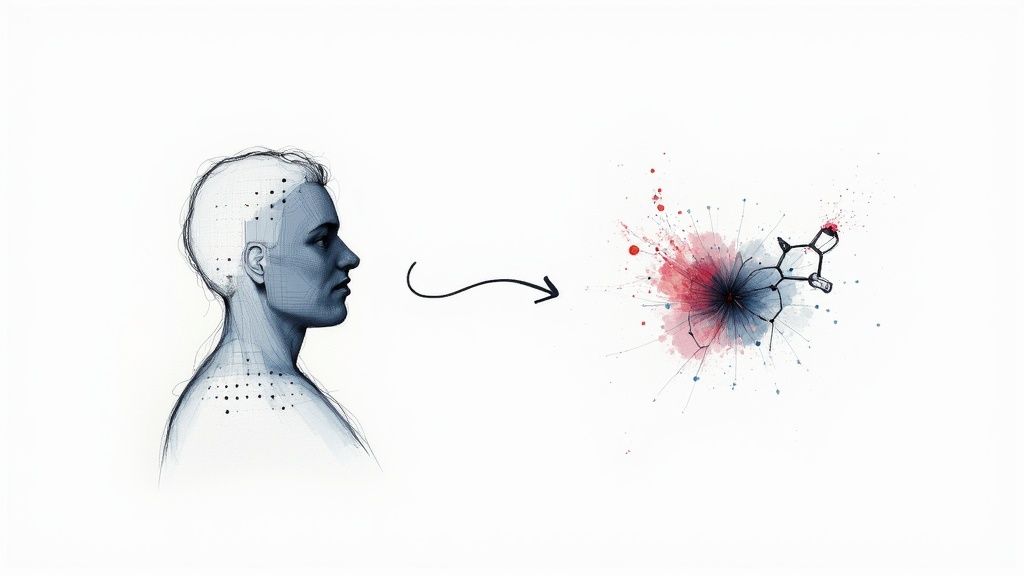
This progress is happening because sophisticated AI tools, once built for business, are now being fine-tuned to solve some of medicine’s toughest problems.
Generative AI in Drug Discovery
One of the most exciting areas is generative AI, which can actually design brand-new molecules from the ground up. Think about it: finding a new drug is usually a long, expensive gamble full of dead ends, often taking a decade and costing billions.
Generative AI flips that script. It learns the fundamental principles of biology and chemistry from massive datasets, then proposes novel drug candidates that are far more likely to work. This could radically shorten the time it takes to get from an idea in the lab to a life-saving treatment in the pharmacy.
The Rise of Digital Twins
Another game-changer on the horizon is the digital twin—a living, breathing virtual replica of a patient. It's built by constantly feeding it real-time data from a person's wearables, electronic health records, and even their genetic code.
With this virtual model, doctors can run simulations. They can test how a specific patient might react to a new medication or surgical plan before ever touching the actual person.
Imagine being able to test a dozen chemotherapy regimens on a patient's digital twin to find the one that attacks the cancer most effectively with the fewest side effects. That’s the power we’re talking about.
This kind of predictive power could completely change how we manage chronic conditions and plan high-stakes surgeries. Of course, since this involves an immense amount of sensitive personal data, understanding what regulatory compliance entails is absolutely non-negotiable for anyone working in this field.
This future—where human expertise is amplified by intelligent technology—is what motivates us. By actively exploring and building on these emerging trends, we're helping to create a healthcare system that's more precise, predictive, and personalized for everyone.
FAQs: Answering Your Medical AI Questions
Will medical AI replace my doctor?
No, the goal of medical AI is not to replace healthcare professionals. Instead, it acts as a powerful support tool, augmenting their expertise. It excels at analyzing vast amounts of data, identifying patterns, and automating routine tasks, which frees up doctors to focus on complex decision-making, patient interaction, and providing empathetic care.
What are the main ethical concerns with AI in medicine?
The primary ethical challenges include ensuring patient data privacy, preventing algorithmic bias, and establishing clear accountability. AI systems must comply with regulations like HIPAA to protect sensitive information. It's also crucial to train models on diverse datasets to avoid perpetuating health disparities. Finally, clear frameworks are needed to determine responsibility when an AI-assisted decision leads to an adverse outcome.
Is AI only for large hospitals?
Not at all. While large institutions may pioneer some applications, smaller clinics can benefit significantly from medical AI. They can start with accessible solutions like AI Automation as a Service to streamline administrative tasks such as scheduling and billing. Adopting specific, cost-effective AI tools that solve a single, well-defined problem is a great way for smaller practices to improve efficiency and patient care without a massive initial investment.
At Ekipa AI, we help organizations of all sizes turn AI potential into real-world impact. From developing a clear strategy to executing complex technical solutions, our expert team is ready to guide you. Explore our AI Solutions to learn more.

